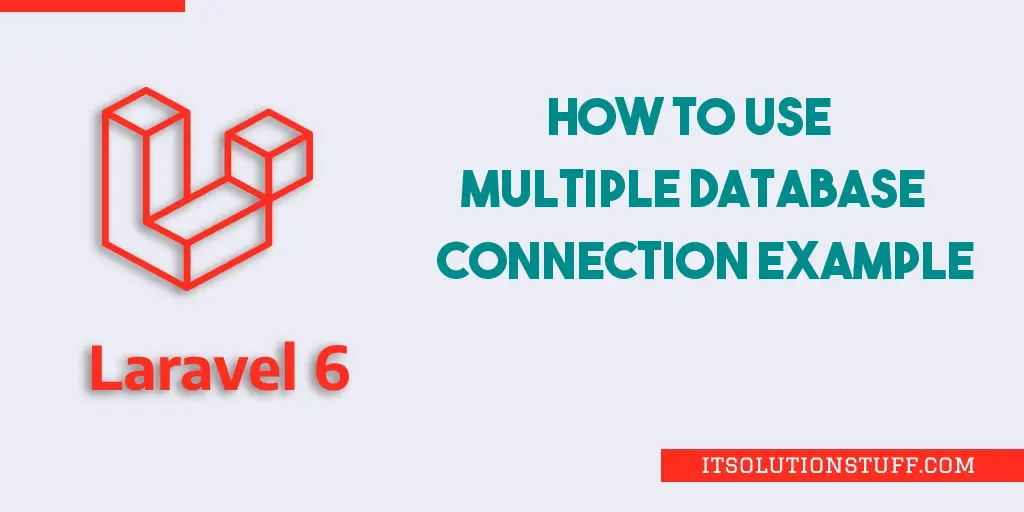Laravel 7/6 Multiple Database Connection Tutorial
Today, i would like to show you how to use multiple db connection in laravel 7/6 application. we will learn to use multi database connection laravel 7/6. you will find out way of implementing laravel 7/6 multiple database connection example.
I will give you step by step implementation of how to use laravel 6 multiple database connections using .env file. we will add configuration variable on .env file and use it to database configuration file. You can just follow me, i will also learn how to work with migration, model and database query for multiple database connection.
As we know sometime we need to use multiple database connection like mysql, mongodb etc. i can say when you work with large amount of project then you will need maybe. So let's follow bellow step.

Set ENV Variable:
Here, you need to set configuration variable on .env file. let's create as bellow:
.env
DB_CONNECTION=mysql
DB_HOST=127.0.0.1
DB_PORT=3306
DB_DATABASE=mydatabase
DB_USERNAME=root
DB_PASSWORD=root
DB_CONNECTION_SECOND=mysql
DB_HOST_SECOND=127.0.0.1
DB_PORT_SECOND=3306
DB_DATABASE_SECOND=mydatabase2
DB_USERNAME_SECOND=root
DB_PASSWORD_SECOND=root
Use ENV Variable:
Now, as we created variable in env file, we need to use that variable on config file so let's open database.php file and add new connections key as like bellow:
config/database.php
<?php
use Illuminate\Support\Str;
return [
'default' => env('DB_CONNECTION', 'mysql'),
'connections' => [
.....
'mysql' => [
'driver' => 'mysql',
'url' => env('DATABASE_URL'),
'host' => env('DB_HOST', '127.0.0.1'),
'port' => env('DB_PORT', '3306'),
'database' => env('DB_DATABASE', 'forge'),
'username' => env('DB_USERNAME', 'forge'),
'password' => env('DB_PASSWORD', ''),
'unix_socket' => env('DB_SOCKET', ''),
'charset' => 'utf8mb4',
'collation' => 'utf8mb4_unicode_ci',
'prefix' => '',
'prefix_indexes' => true,
'strict' => true,
'engine' => null,
'options' => extension_loaded('pdo_mysql') ? array_filter([
PDO::MYSQL_ATTR_SSL_CA => env('MYSQL_ATTR_SSL_CA'),
]) : [],
],
'mysql2' => [
'driver' => env('DB_CONNECTION_SECOND'),
'host' => env('DB_HOST_SECOND', '127.0.0.1'),
'port' => env('DB_PORT_SECOND', '3306'),
'database' => env('DB_DATABASE_SECOND', 'forge'),
'username' => env('DB_USERNAME_SECOND', 'forge'),
'password' => env('DB_PASSWORD_SECOND', ''),
'unix_socket' => '',
'charset' => 'utf8mb4',
'collation' => 'utf8mb4_unicode_ci',
'prefix' => '',
'prefix_indexes' => true,
'strict' => true,
'engine' => null,
],
.....
Use Database Multiple Connection:
Here, i will give you simple example of how you can use as multiple connection:
Use with migration
<?php
.....
public function up()
{
Schema::connection('mysql2')->create('blog', function (Blueprint $table) {
$table->increments('id');
$table->string('title');
$table->string('body')->nullable();
$table->timestamps();
});
}
.....
Use with model
<?php
namespace App;
use Illuminate\Database\Eloquent\Model;
class Blog extends Model
{
protected $connection = 'mysql2';
}
Use with Controller
<?php
class BlogController extends BaseController
{
public function getRecord()
{
$blogModel = new Blog;
$blogModel->setConnection('mysql2');
$find = $blogModel->find(1);
return $find;
}
}
Use with Query Builder
$blogs = DB::table("blog")->get();
print_r($blogs);
$blogs = DB::connection('mysql2')->table("blog")->get();
print_r($blogs);
I hope it can help you...

